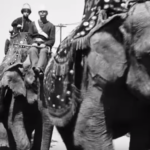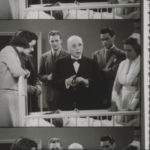Before Hollywood: Betzwood
posted April 26, 2012 3 Comments
![]()
The Betzwood Film Festival
ONE HUNDREDTH ANNIVERSARY SHOW

Science Center Theater, Montgomery County Community College
Blue Bell, Pennsylvania
The Betzwood Film Festival marks the 100th anniversary of the founding of the Betzwood Motion Picture Studio. It features the first and last films made at the famous movie Philadelphia studios: “While matinee idols, Arthur V. Johnson and Ormi Hawley, tangle with fate, the entire population of Toonerville tangles with the most unpredictable public transportation ever devised.”
Film historian Joseph Eckhardt presents an illustrated lecture with Betzwood Archive film clips, vintage photographs, and stories about the making of silent movies in Montgomery County. Films will be accompanied live on the organ by Don Kinnier, and projected by The Secret Cinema’s Jay Schwartz.
The Legacy of Siegmund Lubin
Before Hollywood established itself as the center of American movie-making, the world’s largest and most advanced film factory was Siegmund Lubin’s Betzwood Film Studios, on the banks of the Schuylkill River in North Philadelphia, Pennsylvania.
The studios were built as a supplement to Lubinville, which Lubin had built in Philadelphia. Born in Prussia (modern-day Poland) in about 1841, he was a resident of the U.S. – largely, of Philadelphia and environs – from 1883 until his death at the age of about 82 at his home in Ventnor, New Jersey, just south of Atlantic City. The history of Lubin’s endeavors – as America’s first movie “mogul,” and one who took on the manufacture and distribution of films – is now recounted on an extensive website maintained by three aficionados of the Betzwood era. Based at Montgomery County Community College, they are campus archivist Lawrence Greene, professor emeritus of history Joseph Eckhardt, and emerging technologies librarian Jerry Yarnetsky.

Soon after settling in Philadelphia, Lubin made use of the skills he had gained studying ophthalmology at Heidelberg University, in Germany, to open an optical shop. He spent several years making many thousands of magic lantern slides, of which very few survive. In 1893, by which time he was already in his 50s, he saw Eadward Muybridge’s Zoopraxiscope demonstrated at a Chicago fair, and then studied other early film devices, including the Jenkins/Armat Phantoscope.
In 1896 he bought a Jenkins camera and began making moving pictures – his first was of a horse eating hay. From there, he parlayed his interest into a major industry. He sold projectors and cameras of his own design, and for a time ran his own chain of movie houses around the US Northeast. He made films, first on a platform in the backyard of his home; among them were films of prize fights and shorts for “gentlemen’s smokers.” He even appeared in some of his early films, and in 1908 made a series of films designed to combat anti-Semitism.
An eccentric famous for histrionics in three languages, his ethics were often questions, too. He had to fend off several lawsuits from Thomas Edison and others who claimed patent infringements. He remade Edison’s Great Train Robbery, and exceeded Edison in realizing the promise of moving images, say Eckhardt and his colleagues. For example, he helped to create demand for film by advertising in popular entertainment magazines.
He won his own patents, conceived the idea of “home movies,” and even tried as early as 1904 to market “sound” movies. Ever the entrepreneur, he offered “showman’s packages” with everything a newcomer would need to exhibit movies – including metal facades that instantly converted buildings into theaters, or cardboard ones for the meek of heart.
All that came before 1909, when he sold his theater chain – 17 movie houses in six states – and set up a film-distribution system. He expanded his sales of cameras, projectors, and films, and built a huge studio, “Lubinville,” 20 miles northwest of Philadelphia on a property he bought from the estate of Philadelphia brewer John F. Betz.
At first he made medical and scientific films, and then features. His became one of the most commercially successful movie companies of the early silent era, employing up to 1,000 people. He expanded to Jacksonville, Florida, where he employed Oliver Hardy, and to Los Angeles.
But those studios were shortlived. The Lubin empire foundered, and ended in bankruptcy. Lubin had kept up with the rapid technological advances in filmmaking, but his early keen sense of what audiences would want, particularly poorer Americans, had not. “His storytelling lacked the artistic quality that the public was beginning to expect,” say Eckhardt and his colleagues.
They add: “He would also fail to completely understand the transition of single to multi-reel films, a natural evolution and part of the public’s demand for better narratives. Lubin gambled on the continued thriving of the nickelodeons which showed only single reel films, even while he spent a fortune to produce his own mutli-reel features. In the process he spread himself too thin and when the demand for single reel films disappeared, he could not recoup his losses or make ends meet.”
It had not helped that World War I had deprived him of foreign markets, right after an explosion in a Lubinville film vault destroyed the property, and the master negatives for all his films that were stored there. The last straw was that a motion-pictures patent company in which he was a major player lost a costly lawsuit.
Lubin returned to working in his old optical shop. To the end of his life, he tried to get backing to return to production, but his earlier intuitions and skills for business and self-promotion failed him.
Eckhardt has been researching the history of early film in and around Philadelphia since 1979. His biography of Lubin, The King of the Movies: Film Pioneer, Siegmund Lubin, was published by Fairleigh Dickinson University Press in 1997.
The site he and his colleagues have mounted features rare photographs, film stills, and other documents of the era.
What Remains?
The Betzwood Motion Picture Studio operated from 1912 to 1923 under the ownership of Siegmund Lubin until 1917, and then Wolf Brothers, Inc. of Philadelphia. The 350-acre studio produced more than 100 films, but due to the usual assaults of time and neglect, only 29 films are known to remain in archives in the United States, Great Britain, Germany, and the Netherlands. Few, now, are opportunities to watch such Betzwood stars as the larger-than-life Wilna Hervey.
Each spring, The Betzwood Film Archive at the Library of Montgomery County Community College screens selections from among the films, at its Betzwood Silent Film Festival, (info: 215-641-6518.)
Among the films’ treasured images, says Eckhardt, is this train crash scene from 1914, used in five different Lubin films. The wreck was staged at Phillipsburg, PA, using two old engine scheduled for scrapping. This version is from A Partner to Providence, the eighth installment of the serial The Beloved Adventurer.
– Peter Monaghan
Previous Post: Call for Papers: Archiving the Arts symposium
Next Post: Money for Mountain Films






Hello, I am looking for an army recruitment film, supposedly the first recruitment film, shot by Lubin Motion Picture Company in October 1913 at the Presidio in San Francisco. Any help you can offer in finding a copy of this film would be greatly appreciated.
Thank you,
Rosemary
Rosemary: The best place to inquire about film like that is on the AMIA-L listserv. You can join easily and freely, and people there really do come up with some amazing things. – Best, Peter